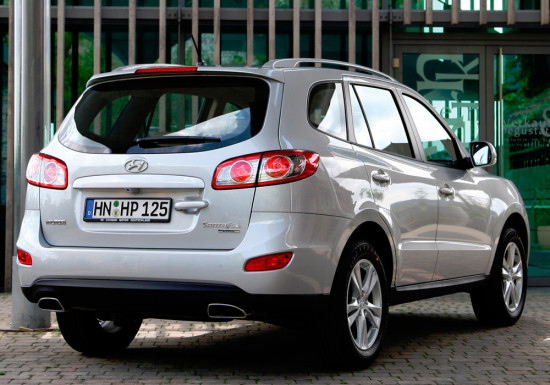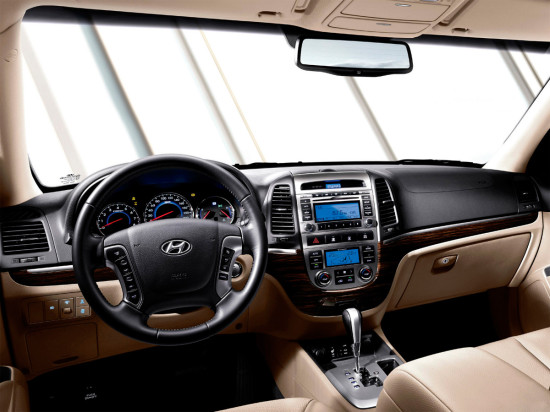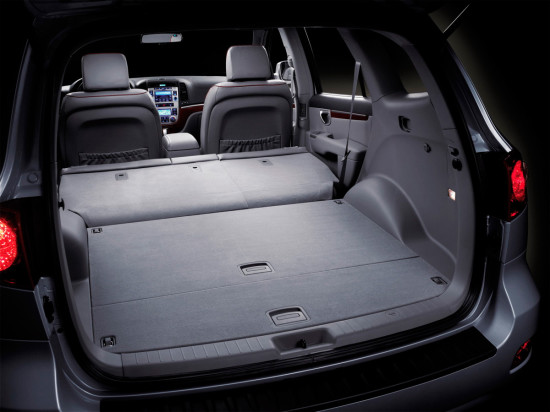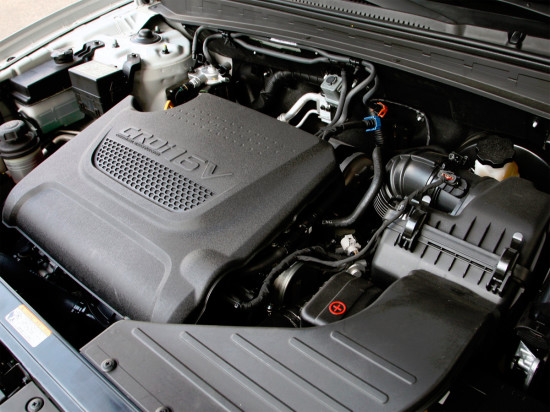The crossover (updated in 2015) shares a platform with several Kia-Hyundai models at once. From the point of view of technical characteristics, the car closest to the Santa Fe is, at the same time, the front suspension of the all-terrain vehicle is similar in design to. In Russia, the restyled 2015-2016 model is offered with two engines: a 2.4-liter Theta II petrol (171 hp) and a 2.2-liter CRDi diesel (200 hp). Both motors have been produced for a long time, but the modernization made it possible to breathe a second life into them. petrol unit equipped with 6MKPP or 6AKPP, diesel is only equipped with an automatic transmission.
System all-wheel drive Hyundai Santa Fe includes an electro-hydraulic controlled Dynamax rear clutch. The Drive Mode switch activates the Sport mode, which provides for a more responsive accelerator pedal and intense spin-up of low gears.
The 2.4 petrol engine is not able to provide a heavy vehicle with good acceleration dynamics. Tandem with manual transmission allows you to reach 100 km / h in 11.0 seconds. Diesel Hyundai Santa Fe is much more agile - he does the same exercise in 9.6 seconds. Plus, the diesel engine is economical, consuming an average of about 7.8 liters of diesel fuel. Fuel consumption Santa Fe 2.4 according to the passport is at least 9.5 liters (modification with mechanical box).
Specifications Hyundai Santa Fe - summary table:
| Parameter | Hyundai Santa Fe 2.4 MPI 171 HP | Hyundai Santa Fe 2.2 CRDi 200 HP | |
|---|---|---|---|
| Engine | |||
| Engine series | Theta II | R-series | |
| engine's type | petrol | diesel | |
| Injection type | distributed | direct | |
| Supercharging | No | eat | |
| Number of cylinders | 4 | ||
| Cylinder arrangement | row | ||
| Number of valves per cylinder | 4 | ||
| Volume, cu. cm. | 2359 | 2199 | |
| Cylinder diameter / piston stroke, mm | 88.0 x 97.0 | 85.4 x 96.0 | |
| Power, hp (at rpm) | 171 (6000) | 200 (3800) | |
| Torque, N*m (at rpm) | 225 (4000) | 440 (1750-2750) | |
| Transmission | |||
| Drive unit | full | ||
| Transmission | 6MKPP | 6automatic transmission | 6automatic transmission |
| Suspension | |||
| Front suspension type | MacPherson type independent | ||
| Rear suspension type | independent, multi-link | ||
| Brake system | |||
| Front brakes | disc ventilated | ||
| Rear brakes | disk | ||
| Steering | |||
| Amplifier type | electric | ||
| Tires and wheels | |||
| Tire size | 235/65 R17 / 235/60 R18 / 235/55 R19 | ||
| Disc size | 7.0Jx17 / 7.5Jx18 / 7.5Jx19 | ||
| Fuel | |||
| Fuel type | AI-95 | DT | |
| Environmental class | Euro 4 | ||
| Tank volume, l | 64 | ||
| Fuel consumption | |||
| City cycle, l/100 km | 13.7 | 14.1 | 10.1 |
| Country cycle, l/100 km | 7.0 | 7.5 | 6.4 |
| Combined cycle, l/100 km | 9.5 | 9.9 | 7.8 |
| dimensions | |||
| Number of seats | 5 | ||
| Number of doors | 5 | ||
| Length, mm | 4690 | ||
| Width, mm | 1880 | ||
| Height, mm | 1680 | ||
| Wheelbase, mm | 2700 | ||
| Front wheel track (17″/18″-19″), mm | 1633/1628 | ||
| Track rear wheels(17″/18″-19″), mm | 1644/1639 | ||
| Front overhang, mm | 940 | ||
| Rear overhang, mm | 1060 | ||
| Trunk volume (min./max.), l | 585/1680 | ||
| Ground clearance (clearance), mm | 185 | ||
| Weight | |||
| Equipped, kg | 1773 | 1793 | 1907 |
| Full, kg | 2510 | ||
| Dynamic characteristics | |||
| Maximum speed, km/h | 190 | 203 | |
| Acceleration time to 100 km/h, s | 11.0 | 11.5 | 9.6 |
Typical Hyundai Santa Fe specifications are due to the use of a fully independent suspension and all-wheel drive transmission without a reduction range. Santa Fe ahead independent suspension McPherson with stabilizers roll stability and gas-filled shock absorbers. Rear - multi-link, independent suspension with HPD shock absorbers (with variable stiffness), coil springs and anti-roll bar. Rear suspension is able to maintain a constant level of ground clearance, regardless of the load of the crossover.
In the updated third Santa Fe, the aerodynamic drag of the body is cx = 0.34, which is the best in the class. A feature of the south Korean crossover is that the Hyundai Santa Fe has four-wheel drive on all the time. center differential asymmetrical, dividing torque between the rear and front wheels in a ratio of 60/40. Coupling in transfer box controls the differential and has the ability to distribute torque between the wheel axles in equal proportions 50/50. The technical characteristics inherent in the Hyundai Santa Fe provide the function of forced disengagement of the multi-plate clutch with a special button located to the left of the steering wheel.
Wheelbase third Hyundai generations Santa Fe remained the same as its predecessor - 2700 mm (2800 in the 7-seater body version). Crossover width 1880 mm. The length of the 5-seat version is 4689 mm, the 7-seat version is 4905 mm. Height 1679 mm (1690 mm in 7-seat version). Ground clearance is 185 mm. The volume of the luggage compartment has increased to 585 liters, and in the seven-seater version - up to 693 liters.
The base engine in the domestic market for Hyundai Santa Fe is a gasoline, 4-cylinder, 16-valve, with a displacement of 2.4 liters (2359 cm3), 175 hp. at 6000 rpm, maximum torque 227 Nm. Equipped with a 6-speed manual gearbox, the Hyundai Santa Fe accelerates from zero to 100 km/h in 11.4 seconds, gaining a top speed of 190 km/h. The average fuel consumption in the combined cycle is 8.9 liters, on the highway 7.3 liters, in the city 11.7 liters per 100 kilometers. The gasoline engine can be aggregated with both mechanical and automatic transmission gears.
Adaptive 6-speed automatic gearbox Hyundai Santa Fe suggests the possibility of manual shifting. The braking system of the SUV is represented by disc brakes with ABS, a stabilization system and a distribution mechanism. braking force. Hyundai Flex Steer electric power steering with three operating modes (Comfort, Normal, Sport).
The second in the line of Hyundai Santa Fe powertrains is a diesel engine. It is installed only in tandem with an automatic transmission. Volume 2.2 liters (2199 cm3), power 197 hp maximum torque 436 Nm. From zero to hundreds of km / h Hyundai Santa Fe diesel accelerates in 10.1 seconds. The maximum speed is 190 km/h. Diesel fuel consumption per 100 km of track is 6.8 liters in the combined cycle, 8.9 liters in the urban cycle, 5.5 liters on the highway.
The second generation of the Santa Fe crossover (a pioneer in the mid-size SUV segment for the Korean manufacturer Hyundai) made its world premiere in January 2006 at the international exhibition in Detroit, and went on sale in April of the same year. In 2010, the debut of an updated car took place at the Frankfurt bride, which received a noticeably refreshed appearance, a modernized interior and two new diesel engines under the hood. On the assembly line, the “Korean” lasted until 2012, when a third-generation model arrived in time to replace it.
Large, heavy and embossed, but not devoid of graceful outlines, the body of the “second Santa Fe” looks interesting and respectable. And if you close the brand emblem, then it can be mistaken for a much more prestigious model. The powerful appearance of the crossover is emphasized by massive sides with developed “muscles”, a large radiator grille, large rims, predatory "squinted" head optics and a pair of trapezoidal pipes of the exhaust system.

The external dimensions of the 2nd generation Hyundai Santa Fe indicate, as we have already noted, that it belongs to the class of mid-size crossovers: 4660 mm long, 1890 mm wide and 1760 mm high. The wheelbase of the machine is limited to the front and rear axles by a 2700 mm gap, and ground clearance in the equipped position it has 203 mm.

The interior of the "second" Hyundai Santa Fe not only looks stylish, but also features high functionality and high-quality finishing materials. Directly in front of the driver is a large "steering wheel" with two blocks of buttons between the hubs, adjustable both in height and reach. The instrument panel with a standard set of readings and large digitization has a simple but modern design.
The symmetrical "aluminum" console in the center of the front panel is framed by graceful air duct deflectors and looks strictly and concisely. It houses a 2-DIN audio system and a large air conditioner with individual monochrome display. The decoration of the crossover is made of high-quality plastics, diluted with aluminum and wood inserts, and the seats are dressed in excellent leather (except for the initial versions).

The 2nd generation Santa Fe front seats are endowed with wide adjustments and tangible support on the sides, but with a somewhat short pillow. But on the back sofa there is a real expanse - for three passengers there is enough space, and for greater convenience, the back of the rear sofa is adjusted according to the angle of inclination.

In the five-seat version luggage compartment the Korean crossover has an impressive volume - 774 liters of usable space, to which a spacious niche in the underground is added (the spare wheel is suspended "on the street" - under the bottom). The split backrest of the second row folds down to form a flat floor and a volume of 1582 liters.
Specifications. For Russian market"second Santa Fe" was completed with two power units to choose from:
- The gasoline version is a four-cylinder "aspirated" with a distributed fuel injection of 2.4 liters, releasing 174 horsepower power at 6000 rpm and 226 Nm of torque at 3750 rpm.
- For the diesel side, the in-line “four” with a turbocharging system, which, with a working volume of 2.2 liters, generates 197 “horses” of potential at 3800 rpm and 421 Nm of possible thrust available in the range from 1800 to 2500 rpm.

For each of the engines, mechanical and automatic transmission(in both cases, six gears). By default, this Hyundai crossover is equipped with an all-wheel drive system, which in normal conditions supplies the entire supply of traction to the front axle, and in the event of slippage of one of the wheels, to rear axle goes up to 50% of its share. This entire process is controlled by an electronically controlled multi-plate friction clutch.
The gasoline version of the Santa Fe 2 takes 10.7-11.7 seconds to accelerate from 0 to 100 km / at top speed at 186-190 km / h, while the diesel one is somewhat more dynamic - 9.8-10.2 seconds and 190 km / h, respectively.
In the combined cycle, a 174-horsepower car consumes an average of 8.7-8.8 liters of fuel, a 197-horsepower car consumes 6.8-7.2 liters.
The basis for the "Santa Fe" of the second generation is a front-wheel drive architecture from hyundai sedan sonata. The design of the front axle provides for the presence of MacPherson struts, and rear axle– independent multi-link suspension. A hydraulic booster is “implanted” into the steering device, and brake system represented by discs on all wheels (front - with ventilation) with ABS and ESC.
Options and prices. For the 2nd generation Hyundai Santa Fe crossover in 2015 on secondary market Russia, on average, is asked from 700,000 to 1,200,000 rubles - the final cost is affected by the year of manufacture, condition, equipment and option installed engine. Even at the simplest level, the “Korean” equipment is well equipped - ABS, airbags, dual-zone “climate”, power steering, fog lights, heated front seats, power windows for four doors and a standard audio system.
The distinguishing feature of this car is spacious salon- we can say the most spacious in this class, and even supplemented by a roomy trunk. The first generation Hyundai Santa Fe is a car for pragmatic buyers. This solid SUV does not differ in exquisite design, high cost of interior trim or magnificent driving performance, but it is difficult to call it clumsy. With this low-cost model discontinued in South Korea this model began to be produced in Taganrog (cars produced under license can be recognized by the prefix “Classic”). If you want to buy a used version, we recommend choosing a copy brought from Korea - most likely, the condition of the car will be much better.
Body and transmission
The body of this car is not afraid of corrosion, and its paintwork has phenomenal durability. The quality of the suspension is also pleasing, most of the parts can withstand about 100,000 km, which is not bad at all for a budget model. But the stabilizer bushings usually have to be changed at around 20,000 km.
Engine range and transmission features
Model comes with gasoline engines, the volume of which can be as follows: 2 l, 2.4 l, 2.7 l or 3.5 l; or with a two-liter diesel engine. The best option a 2.4 liter engine is considered - its power is quite enough for such a car. Of course, fans of an aggressive driving style will like the version with a 2.7-liter engine more. In any case, engines are considered reliable regardless of size. Only the poor quality of gasoline can make them act up. It is for this reason that spark plugs usually have to be changed after 15,000 - 20,000 km.
Experts are sure that all-wheel drive Hyundai transmission Santa Fe is quite reliable. Serious claims against automatic transmission arise only in advanced cases (if the car has been used off-road for a long time). Things are not so good with the mechanics - many owners complain about the capricious clutch and not always correct gear shifting.
Possible problems
Achilles' heel of the model steering rack. At the slightest malfunction, it is better to immediately invest in repairs or preventive maintenance (costing from 8,100 rubles), otherwise you will have to pay later for the replacement of the rail, and this will cost you much more (from 54,000 rubles per official dealers, from 21 500 rubles. - unofficial).
The cost of a used Hyundai Santa Fe is from 300,000 rubles. This is one of the most inexpensive SUVs on the secondary market - at the same time, it is considered quite reliable, is not popular among car thieves and boasts a spacious and comfortable interior.
Hyundai Santa Fe, 2012
The choice fell on Hyundai Santa Fe 2012 model year, we decided to take the basic equipment, always white (well, I like the white color and that's it). I called all the car dealerships, one of them said that such a car would be in a week, that suited me perfectly. A week passed, and my wife and I left the salon on a new car. The dealer offered floor mats, crankcase protection, it seemed a little expensive to me and I refused. "Begged" interior floor mats as a gift. The market promised to bring crankcase protection for 2400r in 2 weeks. Very pleased already toned rear windows, good sound insulation, the door to the bottom, the legs do not get dirty on the thresholds, the fit is comfortable (my height is 176 cm), comfortable second-row seats (adjustable for tilt and “seats” go back and forth), the stove works very well, informative rear-view mirrors , a bunch of drawers under the trunk floor. I can't write much about running characteristics Hyundai Santa Fe, because I decided not to drive the car up to 1000 km. Fuel consumption from 13.5 to 15.5 liters in the city, I hope it will decrease in a couple of thousand km. From the "special stages", I bought and already installed a standard head touch multimedia (Chinese), a TV antenna on the glass, a rear-view camera and parking sensors (they could not be installed, everything is perfectly visible in the camera).
Advantages : design. Comfort inside. Engine. Suspension. Noise isolation.
Vasily, Rostov-on-Don
Hyundai Santa Fe, 2012
Saw in the press new hyundai Santa Fe III generation. Subtracted everything that is possible and on arrival at the salon conducted a test drive. One petrol version is presented for the test. The look in white is great. Salon and thoughtful door seals are beyond praise. Clearance and distance to thresholds sufficient. Sometimes I don’t understand how 185 mm may not be enough, when the Moskvich 2140 had 173, the Japanese had even less, but in their youth they climbed where I don’t go on the “hundred” (L.C.) now. In addition, the measurement actually showed 195-200 mm on an equipped car. The distance from the edge of the wheel to the edge of the wing suggests that it is realistic to put the "rubber" 10-20 mm higher. Although the dealer immediately warned against this seditious thought with a loss of warranty. The engine in the cabin does not “mumble”, the suspension behaves with dignity in terms of extraneous sounds, but this new car and it's too early to judge. Acceleration to “hundreds” was 11.6 seconds, and this was on a non-run-in engine (it was not me driving, but I confess - my idea), there were 3 people in the car, two 100 and one 65 each. The test car gets. Computer consumption 16.8 at the beginning of the test and one tenth less at the end. But here I make allowances for long idling and illogical driving (brake, gas) of many "drivers". In reality, I think it will be less, and the running will make itself felt.
The information content of the displays, both instrumental and multimedia, is rather poor. The display of information could be five points more (travel time, external and internal thermometer readings, etc.) maybe this is, but I apparently did not get to the bottom. Established GPS on Hyundai Santa Fe - did not like it. It is problematic with updating and informativeness, so that "my" Navitel is still better. The trunk is thoughtful and sufficient. Between the lower edge of the rear seat and the edge of the trunk there is another niche - a kind of safe. Although the trunk curtain could be implemented as in the Mazda CX-5 - rising along with the trunk lid.
Ivan, Yuzhno-Sakhalinsk
Hyundai Santa Fe, 2012
What can I say, at first glance and a test for a 175-horsepower unit, Hyundai Santa Fe is quite dynamic. In the city, you can not strain to drive 80 and 120, on the highway it is advisable to keep it on the “tiptronic” in the operating range of 3500-5500, then it has enough dynamics for both overtaking and getting ahead. After the maneuver, you turn on "D" and again peace and quiet in the cabin. At a speed of 180 km / h, the tachometer is 4300 rpm, and in the cabin you can calmly talk and listen to music - the roar of the engine is not annoying and road noise is almost inaudible. On the suspension in the city, on small bumps, you feel discomfort, and on the highway, the Hyundai Santa Fe turns into just a large liner, easily controlled and holding a rut, as if it does not exist at all. The strut stabilizer travel is very large, so it is very difficult to break through the suspension, even when all 4 wheels are off the road (believe me, I have already experienced it). Stabilization system exchange rate stability Hyundai Santa Fe works for all 10 points out of 10 possible, I have not yet experienced smarter “brains” of the car.
According to the ergonomics of the arrangement of instruments in the cabin, a solid "4" out of "5". As for the cross-country ability of the Hyundai Santa Fe, I can say the following, which is a little worse than my previous Hyundai ix35 transshipment car on the “mechanics”. However, half a meter of snow with loose soil for the Hyundai Santa Fe is not a hindrance. The only thing that annoys me is the periodic creaking of the front panel (torpedoes), but I think this happened after the “officials” installed the parking sensors and the “signaling” for me. One gets the feeling that they forgot to fasten something, but in general, the car from the Hyundai concern turned out to be excellent and it is quite worthy of the name “Premium Crossover”.
Advantages : appearance. Salon. Driving qualities.
disadvantages : fuel consumption.
Fedor, Bryansk
